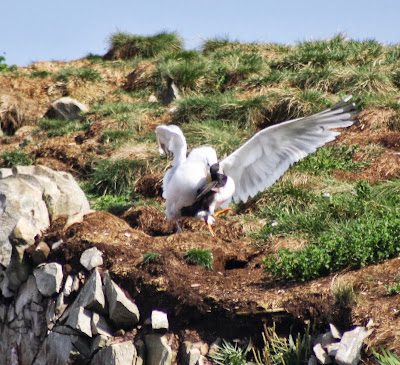Today was a free day for us to explore Gros Morne National Park. The name dates back to a time when the French were fishing the shores. "Gors" means big, "Morne" is a word for small rounded mountain standing alone. In French "Morne" also means dismal or gloomy. It probably means "big isolated hill", when clouds rake across the mountaintops like they were when we came in yesterday the gloomy description is very fitting.
Yesterday was windy and even into the late night with some rain, but this morning it cleared to a beautiful day indeed.
 We are in the park and it is beautiful.
We are in the park and it is beautiful.


 Steps getting down to the beach.
Steps getting down to the beach.
 The beach below the lighthouse.
The beach below the lighthouse. Me between the beach and the lighthouse.
Me between the beach and the lighthouse.  Lighthouse called Lobster Cove Head. It is an interesting shaped lighthouse.
Lighthouse called Lobster Cove Head. It is an interesting shaped lighthouse. Took a hike to one of the many waterfalls here.
Took a hike to one of the many waterfalls here. Saw this interesting flower along the way. The forest is lush with ferns and moss everywhere. So beautiful.
Saw this interesting flower along the way. The forest is lush with ferns and moss everywhere. So beautiful. And tonight we went to a show with a great band. It was fun and funny
Now I will talk about Day 29
Elliston is an incorporated fishing settlement situated on the Bonavistia Peninsula of Newfoundland, Canada. Elliston is known as the Root Cellar Capital of the world and has claimed that title from the 135 root cellars that exist in the community.
Root cellars are for keeping food supplies at a low temperature and steady humidity. They keep food from freezing during the winter and keep food cool during the summer months to prevent spoilage. Typically, a variety of vegetables are placed in the root cellar in the autumn, after harvesting. A secondary use for the root cellar is as a place in which to store wine or home-made alcoholic beverages.
Vegetables stored in the root cellar primarily consist of potatoes, turnips, and carrots. Other food supplies placed in the root cellar over the winter months include beets, onions, preserves/jams, salt meat, salted fish, Winter squash, and cabbage.

 You can see the little island just beyond the rocky area in the bottom of the pic. We are standing on the land in the foreground. The white specks are the seagulls.
You can see the little island just beyond the rocky area in the bottom of the pic. We are standing on the land in the foreground. The white specks are the seagulls.
Our next stop of the day was the puffins. Near a couple of the root cellars we viewed was the closest place to view puffins in all of the kingdom. We were pretty close sometimes they even will come to our side of land and fly in and stop about 8 feet or so from people. Well there were about 40 of us and they were not about to land near all that. Rog and I stayed back to wait and see if they would come then some birders (people whose only thing in life is to watch birds) camped out on the sight were our guide told us they would land. We told the birders and they told us we know and we are still setting up here. The guide was right you can not tell a birder anything. LOL So we decided to head on out, beside Rog had to go, if you know what I mean. 

Puffin pix below.

The seagulls were constantly attacking the puffins. There are a couple of reasons I could put out there. One this is the nesting area and the little puffins are easy prey. Two and I think was happening here is the puffin is catching fish and it is easier eats for the seagull to take away from the puffin.
The pic above looks like a puffin body with seagull wings. The puffin is being attacked.
 Great shot by Rog. This is an island with about a 100 yards, at the most across, away from the peninsula we were standing on and about a 100 feet high.
Great shot by Rog. This is an island with about a 100 yards, at the most across, away from the peninsula we were standing on and about a 100 feet high.


















No comments:
Post a Comment